

Pro Optics 500mm f6.3 Mirror lens - A hands-on review
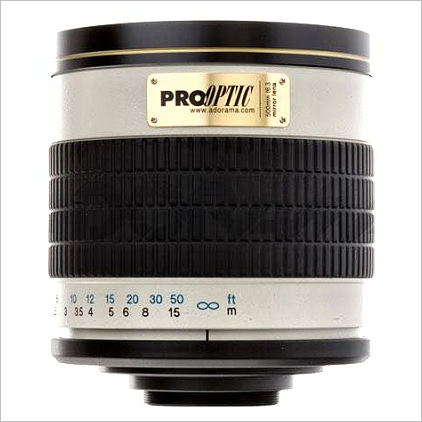
Long telephoto lenses present a dilemma for most photographers. There are long lenses, there are fast lenses, there are cheap lenses and there are sharp lenses, but you will never find a lens with all four characteristics so you have to compromise on one or more of them.
The Pro Optics lens looks interesting on paper. It's 500mm in focal length, so it qualifies as a long lens. It's f6.3, which while not fast isn't that slow. The fastest 500mm lenses are f4.0 and f6.3 is only 1.3 stops slower. There are quite a few 500mm mirror lenses which claim to be f8, so f6.3 would be 2/3 stop faster (but see the section on T-stops below). The price of the Pro Optics 500/6.3 lens with a Canon EOS mount adapter is around $160, which qualifies as cheap in most people's book. Sharpness...you'll have to read on to find out about that.
Pro Optic 500mm f6.3 - Construction
The Pro Optic 500/6.3 appears to be well constructed. The focus action is well damped, smooth and has no backlash. The overall finish of the lens (which is white, or close to it) is good. Focus distances are clearly marked. Since it has a fixed aperture there are no aperture rings or aperture markings. It's threaded for 95mm front filters, though if you buy a filter it may well cost you more than the lens did! The specifications state that it's also threaded at the rear for 34mm filters. The lens comes with a plastic pouch, but there is no lens hood included. The mount is actually a T-mount, but a T-mount to EOS adapter was supplied since the lens was nominally in an EOS mount. T-mount adapters are available for just about every camera ever made, so this lens should be usable on just about any camera that takes interchangeable lenses.
Pro Optic 500mm f6.3 - Specifications
| Focal length: | 500mm |
| Minimum Focusing Distance: | 2m (6.1ft) |
| Maximum Aperture | f/6.3 |
| Optical Construction | 7 elements in 6 groups |
| Filter Diameter | Front 95mm, Rear 34mm |
| Overall Length | 119mm (4.68") |
| Diameter | 98mm (3.86") |
| Weight: | 705g (22 oz) |
Pro Optics 500mm f6.3: Mirror Lenses and T-stops
The Pro Optics 500mm f6.3 is a mirror lens. That doesn't mean it's 100% made of mirrors, but mirrors form a critical part of the optical system. Light comes into the lens and bounces off and is focused by a large mirror at the back. This light then travels away from the camera and hits a smaller mirror in the center of the front lens element, from which it bounces back towards the camera passing though several conventional glass lens elements before being focused on the sensor. While I couldn't find an optical diagram of the Pro Optic 500mm f6.3, I did find one of the Samyang 500 f6.3 and I'm pretty sure these are the same lens, or at least have the same optical design. Samyang make a lot of lenses that appear under different names like Pro Optic, Rokinon, Bower, Optika and a few others.

In the above diagram reflecting elements are shown in red and conventional refracting elements are shown in blue. With all the conventional catadioptric (lens and mirror) designs, the secondary mirror sits on the optical axis and blocks part of the light This means that a lens that is geometrically f6.3 may not be as fast as an unobstructed lens of the same aperture. This is where T-stops come in.
If you had an f2.8 lens and you put a 2 stop ND filter on it, it would still be an f2.8 lens. It would have the depth of field that you'd calculate for an f2.8 lens and the focal length divided by the diameter of the entrance pupil of the lens would be 2.8. However, for exposure purposes it would act like an f5.6 lens. T-Stops take light absorption into account, so though the lens would be f2.8, it would have a T-stop of 5.6. You could also have a lens that was f2.8 in which the optical glass used absorbed some light. That lens might have a T-stop of 3.1 for example. So basically f-stops are a measure of the optical geometry of the lens while T-stops are a measure of the light transmission of a lens. T-stops are rarely used in still photography and for most lenses the difference between the t-stop and f-stop is small. Cinematographers still often use T-Stops though.
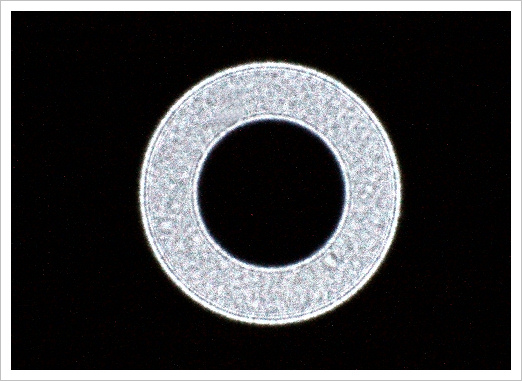
The "donut" shape of out of focus specular highlights shows the shape of the effective iris of the lens
So the speed of a mirror lens is usually less than the f-stop would suggest due to the partial obstruction of light by the secondary mirror in the middle of the lens and also sometimes because you lose more light at a reflecting surface then you do by passing light though a lens element of lens group. The image from the Pro Optic 500/6.3 above indicates that the secondary mirror blocks about 1/3 of the area of the lens aperture. This in itself would result in the loss of about 2/3 stop in effective lens speed (i.e. a T-stop that was 2/3 stop slower than the f-stop). The actual T-stop would also include light losses at the reflecting surfaces and light losses (including surface reflection and bulk glass absorption) when the light passes through the refractive optical elements.
Pro Optic 500mm f6.3 - Exposure

While testing the Pro Optics 500/6.3 I also had on hand a Tamron 500mm f8 mirror lens and a Canon EF 500/4.5L conventional (refractive) telephoto. After shooting the same scenes though each of them at different shutter speeds (and apertures in the case of the Canon lens), I compared images to see what exposures with each of the lenses gave images with the same density.
My conclusion was that both the Tamron 500/8 and Pro Optic 500/6.3 were in fact about the same T-stop, i.e. they both required about the same shutter speed for any given scene at the same ISO setting. I found that the two mirror lenses needed the same shutter speed when they were wide open (which is all the time of course) as the Canon lens did when to to about f10. This would indicate that both the Pro Optic 500/6.3 and the Tamron 500/8 are lenses with T-stop of around 10. Somewhat surprising, but I checked these numbers several times on different subjects using different cameras (EOS 7D and EOS 5D) with the same conclusion.
Exposure was accurate on both an EOS 5D and an EOS 7D in aperture priority mode and using the camera's internal metering in manual mode.
Pro Optic 500mm f6.3 - Handling
Since the Pro Optic 500/6.3 is so small and light, there's a temptation to handhold the lens. With a 500mm lens this can be a problem if you want images that aren't softened by camera movement. The "rule of thumb" is that you need a shutter speed of at least 1/focal-length for a lens on full frame, or a speed 1.6x that for APS-C (since APS-C images have to be enlarged 1.6x more to get to the same print size as full frame images, the need to be sharper to start with) So if we assume 1/500s for full frame and 1/800s for APS-C and we assume a T-stop of f10 that means we need an ISO setting of around 320 even in bright sunlight. Once the lighting dims due to clouds or the sun going down, the ISO has to go up.
So a 500mm lens without IS really needs a tripod. Actually a tripod is needed for two reasons. The first is to keep the camera steady and so allow slower shutter speeds and lower ISO settings. The second is to allow manual focus. If you can't hold the lens steady, it's very hard to tell when you have best focus. It's hard enough anyway since the image isn't very bright, but if the image is moving around it's virtually impossible to focus accurately. Focus is best done using live view with the lens on a tripod.
Also note that just because the lens is small and light doesn't mean you can get away with a small and light tripod. This is a 500mm lens and it needs some mass and stability in the tripod legs and head. Put it on a small light tripod with a small ball head, tap it and the image will shake for seconds.
The AF confirmation chips do not seem to work well with mirror lenses, at least I've had little luck with them. It may be because of the nature of the optics with the central obstruction or it may be that they are just too slow, at least for the Canon AF system which requires f5.6 for best operation.
Pro Optic 500mm f6.3 - Focal Length
You can't always trust the focal length marked on lenses. Some manufacturers stretch the truth a little and a nominal 500mm lens might be as short as 480mm. It seems that a 5% margin is "allowable" in the industry. However in this case, 500mm was pretty much 500mm. In fact all three lenses, the Pro Optic 500/6.3, the Tamron 500/8 and the Canon 500/4.5L were within a few mm of 500mm.
Pro Optic 500mm f6.3 - Backgrounds and bokeh
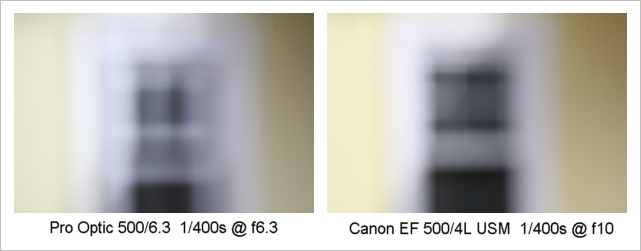
Due to the central obstruction all mirror lenses produce what are sometimes referred to as "nervous" Bokeh, i.e. fragmented and structured out of focus regions, rather then the smooth and diffuse out of focus areas which are normally considered more desirable (=better bokeh). The Pro Optic 500/6.3 is no exception of course. There's really nothing you can do about this. In images where everything is at the same distance from the lens it's not an issue, but that's restricted to things like shots of the moon (see below) or images of flat objects like paintings and posters. Also if the background is smooth and continuous (like the sky, a photo backdrop or a uniform wall), the effects of the lens' central obstruction on out of focus regions won't be evident.
The images in the earlier section on exposure also show the effect of the obstructed aperture on bokeh.
Pro Optic 500mm f6.3 - Optical Quality
Let me say at the outset that there is a price difference between the three lenses under comparison. The Pro Optic 500mm f6.3 sells for around $149. About 10 years ago the Tamron 500/8 sold for around $400, which means that if it was still available (which it isn't) it would probably be selling for at least $500. The Canon 500/4.5L was around $3000 20 years ago. Today it would probably sell for well over $5000 and in fact even a used one will cost you at least $3500 and probably more. So we're not exactly comparing apples with apples here.
That being said here are some resolution test images. They were shot using an EOS 7D and focusing was done using Live View with 10x magnification on the camera's LCD screen. The camera and lens were mounted on a heavy tripod and a remote shutter release was used. These are just examples from a larger set of test images.
The images below are of two different resolution targets. Each sample is a 100% crop from the center of the image.
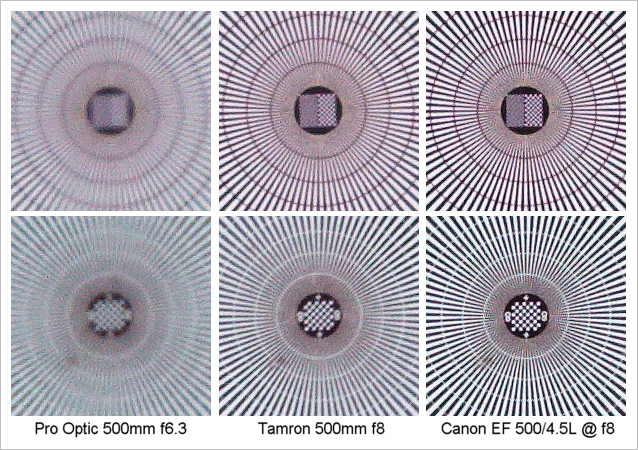
Well, it's pretty clear that the Pro Optic lens isn't as sharp as either the Tamron mirror lens or the (very much more expensive) Canon 500/4.5L. The Tamron actually does surprisingly well. The Pro Optic lens is down in both contrast and resolution. These images were taken with the target around 25m from the lens. To look at sharpness at infinity I took the following images of the moon.
.jpg)
Again you can see the same trend. The Pro Optic is a little soft, the Tamron is quite a bit sharper, but the Canon 500/4.5L is the best (and so it should be). These are unedited shots with no sharpening or contrast manipulation.
Pro Optic 500mm f6.3 - is it sharp enough?
So clearly the Pro Optic 500mm f6.3 isn't likely to be the sharpest lens in your camera bag, but the real question is whether it's sharp enough to be usable and, considering that it's only $149, whether it's worth the price. Well, here's a shot of the moon after quite a bit of work has been done on it including sharpening, increasing overall contrast and microcontrast, adjusting tone curves, clipping the histogram and adjusting color balance. The enlargement is a 50% crop from the original.
First the full frame:

Pro Optic 500mm f6.3 on EOS 7D. 1/400s, ISO 400
And now a crop at ~50%
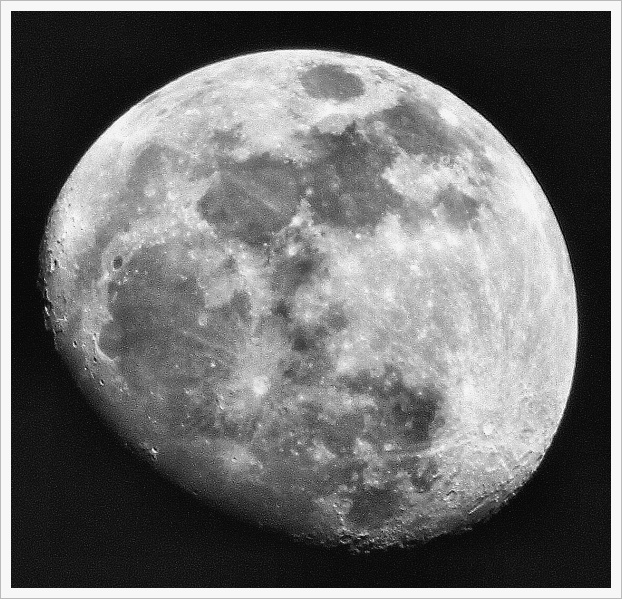
Not that bad. If you don't look too closely at the images and you're prepared to do a little work with an image editor and you're not looking for poster sized prints, the Pro Optic 500/6.3 isn't a bad buy at $149.
Here's another example. First the whole frame. Note the "nervous" bokeh of the background too.
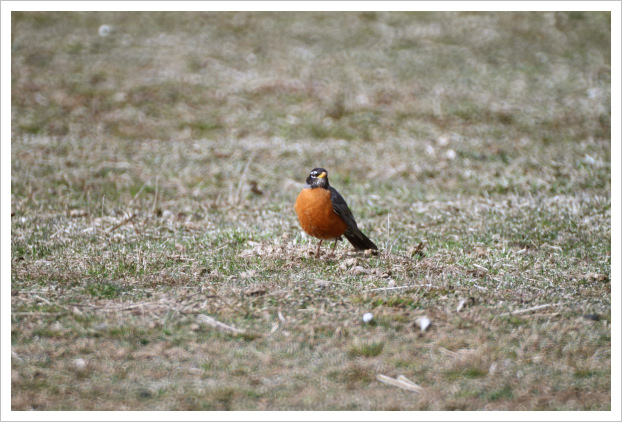
Now here's a 50% crop of the bird straight out of the camera

50% crop, no sharpening
and here it is after taking the RAW file, applying sharpening to it, converting it to a JPEG and further sharpening it
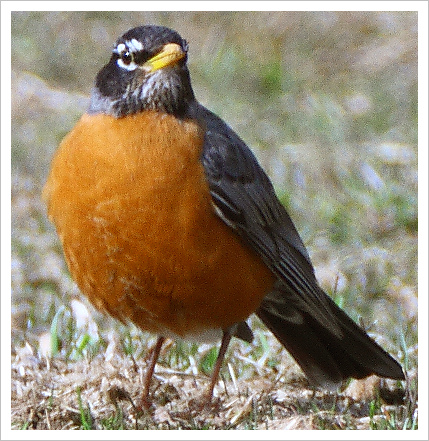
50% crop after sharpening
It doesn't look too bad, so with some work you can get acceptable small to medium size images from the Pro Optic 500/6.3, jut don't expect razor sharp images and don't expect sharp images without doing a little work on them.
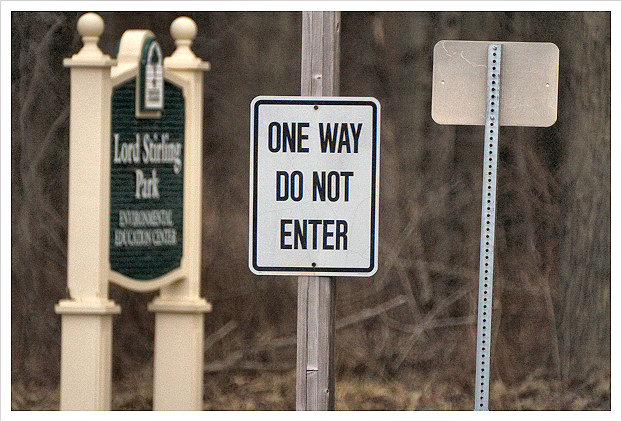
Pro Optic 500/6.3 on EOS 7D. The whole frame is shown. 1/3200s , ISO 3200
Pro Optic 500mm f6.3 : Conclusions
I think the bottom line on the Pro Optic 500/6.3 is pretty much "you get what you pay for". It's a very inexpensive 500mm lens. At $160 it's a low cost lens that can provide an entry into the world of telephoto photography. With some post-exposure digital processing you can get images of acceptable sharpness which are perfectly fine for web display and smaller prints. It's a lens that might be fun to play with, but it's probably not a tool you'd want to try to use for serious telephoto work.
Pro Optic 500/6.3 - Alternatives
.jpg) The alternatives to the Pro Optic 500mm f6.3 are few and far between. There are other low cost 500mm mirror lenses, but none have a reputation for being particularly sharp. If you want a 500mm lens with AF and image stabilization you're looking at a minimum cost of around $1000. For that you can find the . You get autofocus, variable aperture, image stabilization and a lens with three SLD elements for higher image quality. You also get a zoom. It's still not going to be as sharp as a good 500mm prime, but it is about 1/5th the cost.
The alternatives to the Pro Optic 500mm f6.3 are few and far between. There are other low cost 500mm mirror lenses, but none have a reputation for being particularly sharp. If you want a 500mm lens with AF and image stabilization you're looking at a minimum cost of around $1000. For that you can find the . You get autofocus, variable aperture, image stabilization and a lens with three SLD elements for higher image quality. You also get a zoom. It's still not going to be as sharp as a good 500mm prime, but it is about 1/5th the cost.
 Another alternative is to be content with a shorter focal length and maybe try to get a little closer to your subject (e.g. by using a blind if you're photographing wildlife). You can then go with the excellent . It's a great lens (I have one myself). It's not 500mm but it's sharp, small, relatively light and the IS and AF work well making it easy to handhold without a tripod. You can add a Tamron 1.4x TC and the image quality holds up pretty well, giving you 420mm at f8. You lose AF on most DSLRs, but I've found that contrast detection in Live View works fine with this combination on my EOS 7D. Even without AF you still retain image stabilization and automatic aperture control - which of course you don't have with a mirror lens.
Another alternative is to be content with a shorter focal length and maybe try to get a little closer to your subject (e.g. by using a blind if you're photographing wildlife). You can then go with the excellent . It's a great lens (I have one myself). It's not 500mm but it's sharp, small, relatively light and the IS and AF work well making it easy to handhold without a tripod. You can add a Tamron 1.4x TC and the image quality holds up pretty well, giving you 420mm at f8. You lose AF on most DSLRs, but I've found that contrast detection in Live View works fine with this combination on my EOS 7D. Even without AF you still retain image stabilization and automatic aperture control - which of course you don't have with a mirror lens.
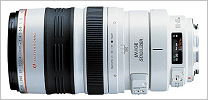 A good choice for a telephoto zoom longer than the typical 300mm lenses would be the excellent , It's currently available for $1380 which isn't cheap, but it's worth it. It gives you image stabilization and fast AF, contrast and sharpness are excellent, even wide open at 400mm. The only "affordable" 400mm lens that's better is the which is currently available for $1299. This is a very, very good lens. Very sharp, very fast AF (ideal for birds in flight). It doesn't have any image stabilization though, which could be a drawback in some situations. I'd say it's currently the best low cost telephoto over 300mm from any manufacturer.
A good choice for a telephoto zoom longer than the typical 300mm lenses would be the excellent , It's currently available for $1380 which isn't cheap, but it's worth it. It gives you image stabilization and fast AF, contrast and sharpness are excellent, even wide open at 400mm. The only "affordable" 400mm lens that's better is the which is currently available for $1299. This is a very, very good lens. Very sharp, very fast AF (ideal for birds in flight). It doesn't have any image stabilization though, which could be a drawback in some situations. I'd say it's currently the best low cost telephoto over 300mm from any manufacturer.
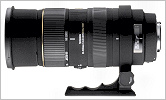 Finally, if you want the ultimate "affordable" uber-zoom, take a look at the . I tested this lens a year or so ago and I was quite impressed with it. Image quality at 500mm and f6.3 is pretty good. Not as good as a $5000 prime 500mm lens, but still quite decent. Right now with the current Sigma rebate it sells for around $1510. Again not cheap but as I said at the beginning of this review, you can have sharp, you can have long, you can have cheap and you can have fast - but you can't have them all at the same time!
Finally, if you want the ultimate "affordable" uber-zoom, take a look at the . I tested this lens a year or so ago and I was quite impressed with it. Image quality at 500mm and f6.3 is pretty good. Not as good as a $5000 prime 500mm lens, but still quite decent. Right now with the current Sigma rebate it sells for around $1510. Again not cheap but as I said at the beginning of this review, you can have sharp, you can have long, you can have cheap and you can have fast - but you can't have them all at the same time!
UPDATE: Several new Telephoto zooms appeared in 2014/15. They are all good and well worth consideration. They are:
- The A very good lens - see My review
- The . This is the "S" or "Sports" version with the best optics
- The . This is the "C" or commercial version with the lowest price
